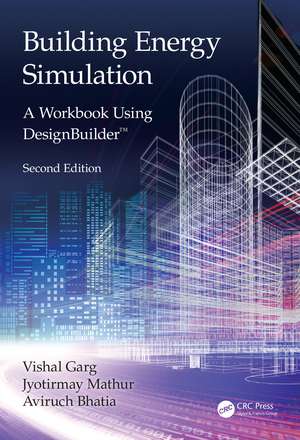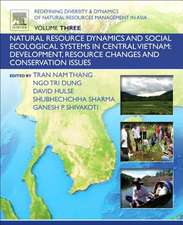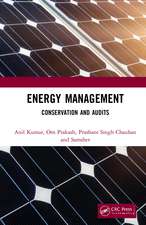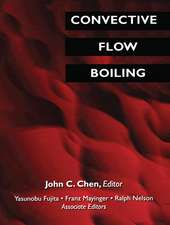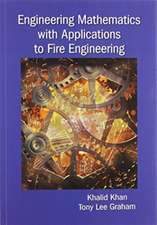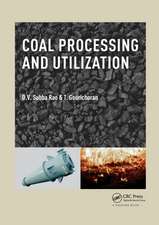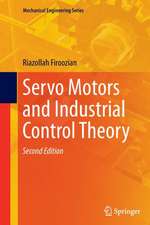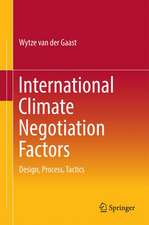Building Energy Simulation: A Workbook Using DesignBuilder™
Autor Vishal Garg, Jyotirmay Mathur, Aviruch Bhatiaen Limba Engleză Paperback – 7 sep 2020
Features:
Focuses on learning building energy simulation while being interactive through examples and exercises.
Explains the building physics and the science behind the energy performance of buildings.
Encourages an integrated design approach by explaining the interactions between various building systems and their effect on energy performance of building.
Discusses a how-to model for building energy code compliance including three projects to practice whole building simulation.
Provides hands-on training of building energy simulation tools: DesignBuilder™ and EnergyPlus.
Includes practical projects problems, appendices and CAD files in the e-resources section.
Building Energy Simulation is intended for students and researchers in building energy courses, energy simulation professionals, and architects.
| Toate formatele și edițiile | Preț | Express |
|---|---|---|
| Paperback (1) | 644.93 lei 6-8 săpt. | |
| CRC Press – 7 sep 2020 | 644.93 lei 6-8 săpt. | |
| Hardback (1) | 1593.31 lei 6-8 săpt. | |
| CRC Press – 7 sep 2020 | 1593.31 lei 6-8 săpt. |
Preț: 644.93 lei
Preț vechi: 850.69 lei
-24% Nou
Puncte Express: 967
Preț estimativ în valută:
123.41€ • 129.11$ • 102.52£
123.41€ • 129.11$ • 102.52£
Carte tipărită la comandă
Livrare economică 02-16 aprilie
Preluare comenzi: 021 569.72.76
Specificații
ISBN-13: 9780367374686
ISBN-10: 0367374684
Pagini: 740
Ilustrații: 146 Tables, black and white; 972 Illustrations, black and white
Dimensiuni: 178 x 254 x 54 mm
Greutate: 1.56 kg
Ediția:2 ed
Editura: CRC Press
Colecția CRC Press
ISBN-10: 0367374684
Pagini: 740
Ilustrații: 146 Tables, black and white; 972 Illustrations, black and white
Dimensiuni: 178 x 254 x 54 mm
Greutate: 1.56 kg
Ediția:2 ed
Editura: CRC Press
Colecția CRC Press
Cuprins
1. Getting Started with Energy Simulation. 2. Geometry of Buildings. 3. Material and Construction. 4. Openings and Shading. 5. Lighting and Controls. 6. Heating and Cooling Design. 7. Unitary HVAC systems. 8. Heating Ventilation and Air Conditioning – Central Water Side. 9. Heating Ventilation and Air Conditioning – Central Air Side. 10. Natural Ventilation. 11. Simulation Parameters. 12. Renewable Energy System. 13. Costing, Sensitivity and Uncertainty Analysis. 14. Building Energy Code Compliance.
Notă biografică
Vishal Garg is professor and head of the Center for IT in Building Science, International Institute of Information Technology (IIIT), Hyderabad, India. His current research interests are in the areas of energy simulation, smart homes and cool roofs. He teaches building automation and controls, energy simulation, and illumination engineering. He has conducted several national and international workshops on intelligent buildings, green buildings and energy simulation. He holds a BTech (Hons.) degree in civil engineering from MBM Engineering College, Jodhpur, India and a PhD from the Indian Institute of Technology, Delhi, India. Dr. Garg is actively involved in the green building movement, and in developing eTools and educational platforms for advancing energy efficiency in buildings and energy efficiency building code and its implementation. He was the founding president of the Indian chapter of the International Building Performance Simulation Association (IBPSA) and chaired the organizing committee of the International Conference for Building Simulation 2015 and the International Conference on Countermeasures to Urban Heat Islands (IC2UHI) 2019. He is a fellow of IBPSA and received the inaugural Arthur H. Rosenfeld Urban Cooling Achievement Award in 2018.
Jyotirmay Mathur is professor of mechanical engineering and the founding head of the Centre for Energy and Environment at Malaviya National Institute of Technology, Jaipur, India. He has done postgraduate work in energy studies at the Indian Institute of Technology, Delhi, India, and has received a doctorate in energy systems from the University of Essen, Germany. Dr. Mathur has published 80 research papers in refereed international journals and has presented more than 150 papers and talks at international seminars and conferences, besides writing five books. Dr. Mathur works in the field of energy modelling, codes and standards, energy conservation in buildings, passive cooling, adaptive thermal comfort and building integrated photovoltaic systems.
Aviruch Bhatia is assistant professor at the TERI School of Advanced Studies, New Delhi, India. He holds a PhD from the International Institute of Information Technology, Hyderabad, India, an MTech degree in energy engineering from the Malaviya National Institute of Technology, Jaipur, India, and MSc and MPhil degrees in physics from the University of Rajasthan, Jaipur, India. His areas of interest include building physics, calibrated energy simulation and fault detection and diagnostics in heating, ventilation and air conditioning systems. He has also worked for three years as an assistant manager at Sustainability Group of Spectral Consultant, Pvt. Ltd. (an AECOM company).
Jyotirmay Mathur is professor of mechanical engineering and the founding head of the Centre for Energy and Environment at Malaviya National Institute of Technology, Jaipur, India. He has done postgraduate work in energy studies at the Indian Institute of Technology, Delhi, India, and has received a doctorate in energy systems from the University of Essen, Germany. Dr. Mathur has published 80 research papers in refereed international journals and has presented more than 150 papers and talks at international seminars and conferences, besides writing five books. Dr. Mathur works in the field of energy modelling, codes and standards, energy conservation in buildings, passive cooling, adaptive thermal comfort and building integrated photovoltaic systems.
Aviruch Bhatia is assistant professor at the TERI School of Advanced Studies, New Delhi, India. He holds a PhD from the International Institute of Information Technology, Hyderabad, India, an MTech degree in energy engineering from the Malaviya National Institute of Technology, Jaipur, India, and MSc and MPhil degrees in physics from the University of Rajasthan, Jaipur, India. His areas of interest include building physics, calibrated energy simulation and fault detection and diagnostics in heating, ventilation and air conditioning systems. He has also worked for three years as an assistant manager at Sustainability Group of Spectral Consultant, Pvt. Ltd. (an AECOM company).
Descriere
The 2nd edition of Building Energy Simulation includes study of various components and systems of a building and their effect on energy consumption, with the help of DesignBuilderTM supported by examples and exercises. It explains simulation input parameters and how to do analysis of the simulation output explaining building physics concepts.
